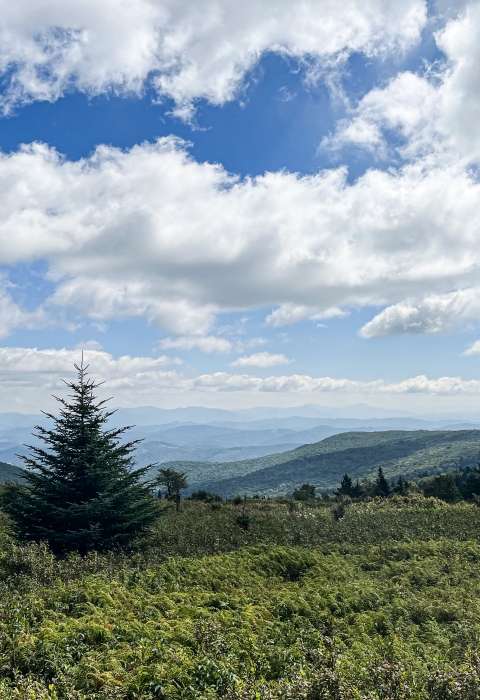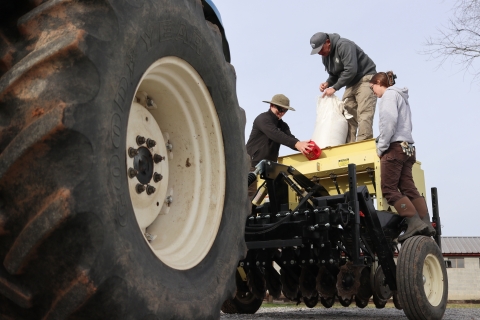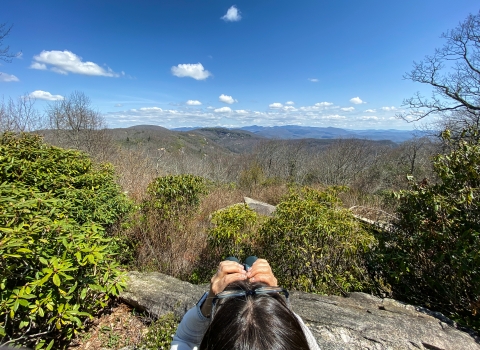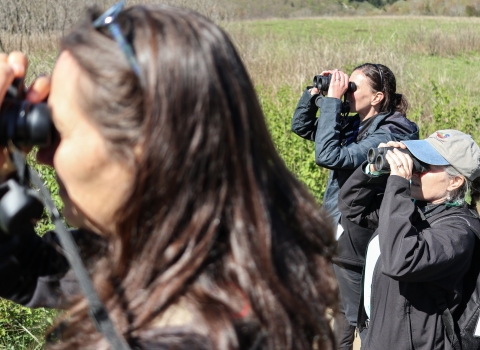March 29
Prescribed fire review - Prescribed fire is a key tool in land management across much of the Southeast. Asheville Field Office biologist Rebekah Reid recently completed Endangered Species Act review of 14 prescribed fire projects, covering nearly 11,000 acres, that are slated for the National Forests of Western North Carolina, representing the majority of the 2024 prescribed fire workload on these forests. This review entails identifying impacts to threatened and endangered species and critical habitat, and working to minimize or eliminate those impacts.
March 22
Swamp pink genetics – Swamp pink is a federally threatened wetland plant occurring from Georgia to New Jersey. Asheville Field Office biologist Dr. Natali Ramirez-Bullon joined U.S. Forest Service staff and Appalachian State graduate student Kate Loughran as Loughran gathered tissue samples from swamp pink plants on Pisgah National Forest. The sample will contribute to her work conducting a genetic diversity analysis of swamp pink populations across North Carolina.
Brown bag lunch – The Asheville Field Office recently completed their winter, internal, brown bag lunch series with a presentation by Gary Peeples on the history of Mountain Bogs National Wildlife Refuge, a refuge the Asheville office played a large role in establishing. The series was established to build office community during an era of telework and to share an understanding of the breadth of the office’s work among all staff members. This presentation was the fifth in the series, which included talks on pollinator conservation, the consultation process, species listing and SSAs, and plant recovery.
Pollinator presentations – Asheville biologist Bryan Tompkins recently presented on pollinator conservation to several classes at T.C. Roberson High School and Buncombe County Early College in Buncombe County, N.C. Tompkins has spoken to over 300 students in the past two weeks. The presentations are part of a broader partnership Tompkins has spearheaded with Buncombe County and surrounding county schools that has had him providing pollinator conservation presentations to classes and facilitating the installation of schoolyard pollinator gardens. Educators with the school system have developed a kindergarten - 12th grade pollinator-centric curriculum to accompany the presentations and garden installations.
March 15
Office first aid class – With field season on the cusp of ramping up, staff from the Asheville Field Office recently completed CPR/wilderness first aid training. Byron Hamstead, Mark Endries, Jay Mays, Laura Fogo, Jeff Quast, Karla Quast, and Andrew Hamstead all completed the class. The office took advantage of the staff gathering to have an early Pi Day celebration with a pie-centric pot-luck lunch.
Bog Learning Network – Southern Appalachian bogs are a suite of rare wetland types that are home to several species protected by the Endangered Species Act. The Bog Learning Network was created more than a decade ago to bring together conservationists working in these wetlands. This year’s meeting was recently held on the campus of UNC-Asheville, and included Asheville Field Office biologists Dr. Natali Ramirez-Bullon speaking on pitcher plant hybridization and Sue Cameron speaking on the process for considering the bog turtle’s southern population for additional Endangered Species Act protection.
March 8
National Forest site visit –Asheville Field Office biologists Rebekah Reid and Sue Cameron joined biologists and silviculturalists from the U.S. Forest Service to visit sites on Nantahala National Forest and discuss how to minimize impacts to Federally protected bats during timber harvests. Due to white-nose syndrome, once common bats have become imperiled, leading to discussions about how federal agencies can meet their Endangered Species Act obligations to these species. These bats are often habitat generalists that can be found across wide swaths of the landscape, as opposed to small areas of specialized habitat.
Advancing red spruce restoration – Red spruce is a key habitat component for northern flying squirrels, including the endangered Carolina northern flying squirrel. Work to restore red spruce in the central and southern Appalachians has long been underway but is poised to accelerate with the potential for additional restoration work on national forests. To help plan for that potential work, Asheville Field Office biologists Rebekah Reid and Sue Cameron participated in a meeting of a red spruce technical advisory group, helping define how red spruce restoration on national forests might be accomplished so the U.S. Forest Service can appropriately comply with environmental regulations.
Mollusk conservationists come together – The Freshwater Mollusk Conservation Society (FMSCS) is the world’s preeminent professional organization focused on the conservation of freshwater mollusks like mussels and snails, and the southeastern United States is a global epicenter of freshwater mussel diversity. Asheville Field Office biologist Andrew Henderson attended the 2024 FMCS biennial workshop, held this year in Auburn, AL. The biennial workshop is focused on bringing researchers and managers together to help ensure the data that managers need to make good decisions about mussel management exists and is accessible.
February 22
Mills River pollinator planting – A focal point of the community of Mills River, N.C. is the 48-acre Mills River Park, which nods to the natural heritage of the area with river access for paddling and snorkeling and a recently planted 15-acre pollinator meadow. The field will be a mixture of wildflowers and native grasses, complimenting a previously installed pollinator garden, and is the culmination of a lot of teamwork at the local, state, and federal levels. The town of Mills River provided the land – Mills River Park – and a vision for the park that incorporated the pollinator meadow; the North Carolina Wildlife Resources Commission provided the equipment – a tractor and seed drill that simultaneously cuts the soil surface and drops seed into the cut - and staff to operate it; and the Service provided technical support in planning the meadow and funding for seeds through its Partners for Fish and Wildlife program.
Southeast Bat Diversity Network meeting – Asheville Field Office biologist Sue Cameron recently attended the 2024 Annual Southeast Bat Diversity Network Meeting and Colloquium on the Conservation of Mammals in the Southeastern United State, held in Hilton Head, S.C. with more than 200 participants. Cameron serves as the secretary for the bat diversity network and is the bat expert for the Asheville office.
Review of the Woodfin Wave – The Woodfin Wave is a proposed hardscaped whitewater paddling park on the French Broad River, in Woodfin, N.C. Asheville Field Office biologist Byron Hamstead recently completed formal review of the project which would occur in the habitat of the endangered Appalachian elktoe mussel. The project requires a permit from the U.S. Army Corps of Engineers, which incorporated numerous conservation measures related to sediment and erosion control, how in-stream construction will be conducted, and minimizing impacts to bats.
February 15
Bat bridge exclusion – During warmer months, endangered gray bats are known to roost on a McDowell County, N.C. road bridge currently slated for maintenance by the N.C. Department of Transportation. To keep those bats out of harm’s way should they return to the bridge while maintenance is underway, Asheville Field Office biologist Holland Youngman recently worked with NCDOT staff and a state of North Carolina biologist to temporarily seal the joints where the bats roost, preventing the endangered bats from crawling into the bridge’s nooks and crannies while maintenance work is underway. When maintenance work is complete, the sealing will be removed, enabling the bats to roost on the bridge once again.
February 8
Electrofishing safety – Electrofishing is a field technique in which an electrical current is passed through water to temporarily stun fish, allowing biologists to easily collect and handle the animals for activities like collecting data or attaching tags. The Service is currently revising safety protocols governing the use of electrofishing by Service biologists. Asheville Field Office biologist Jason Mays recently joined Service biologists from across the country as well as workplace safety experts to begin updating the procedures.
Swain County mine work – Swain County, N.C. is home to a pair of remote, abandoned copper mines now used by hibernating Rafinesque's big-eared, little brown, tricolored, and big brown bats. Asheville Field Office biologist Sue Cameron recently joined biologists with the N.C. Wildlife Resources Commission as they boated, rode utility vehicles, and hiked to reach the remote mines to conduct the latest bi-annual survey of hibernating bats. Results were mixed, with one mine having decreased bat numbers while the other had solid numbers.
Sicklefin redhorse meeting – Aquatic biologists recently convened in a conference room on the north side of Asheville, N.C. to review the latest research on sicklefin redhorse and chart a course for upcoming field work. The Service was represented by Jay Mays from the Asheville Field Office and Ian Paige and Michael Fulghum from Warm Springs National Fish Hatchery and they were joined by biologists from Duke Energy, the Eastern Band of Cherokee Indians, Georgia Department of Natural Resources, North Carolina Wildlife Resources Commission, and the Tennessee Valley Authority. The sicklefin redhorse was once considered for Endangered Species Act protection and has been the focus of a concerted conservation effort to get ahead of the need for such protection.
Assisting the Florida Ecological Services Office – Asheville Field Office biologist Andrew Henderson began a one-month detail as manager of the classification and recovery division in the Florida Ecological Services office a position held by Lourdes Mena, who, in turn, is currently on a detail to the Caribbean Field Office. In recent years Henderson has gained extensive listing experience, serving as the lead field biologist for eight wide-ranging freshwater mussels considered for Endangered Species Act protection.He is also an instructor for the Endangered Species Act listing course offered at the Service’s National Conservation Training Center.
Flying squirrel monitoring – Recent years have seen a significant uptick in efforts to restore red spruce on the highest peaks of southern Appalachia, an effort that builds on modeling and mapping work done by Asheville Field Office biologist Mark Endries, an expert in the analysis and use of geographic data. One of the species slated to benefit from this restoration effort is the endangered Carolina northern flying squirrel. Endries recently joined biologists with the N.C. Wildlife Resources Commission for part of their wintering monitoring of the endangered squirrel, providing a chance to step away from his computer-focused work to see the species in its habitat and assist field biologists in their effort to track squirrel populations.
February 1, 2024
Avery County mine bat survey – A former iron mine in Avery County, N.C. was once one of the most important bat hibernacula in North Carolina, though the number of bats hibernating in the mine has dropped dramatically since the arrival of white-nose syndrome. Asheville Field Office biologist Sue Cameron recently joined state biologists to assist with their bi-annual survey of bats in the mine. Now under permanent conservation ownership, the mine is home to little brown, big brown, and tricolored bats.
January 25, 2024
Roan Mountain Stewardship Committee - Roan Mountain is one of the signature natural areas of Southern Appalachia as it is one of the highest peaks east of the Mississippi, home to six threatened or endangered species, traversed by the Appalachian Trail and the site of grass-covered peaks that draw in vista-seekers. As such, management of the area involves several key stakeholders, organized as the Roan Mountain Stewardship Committee. Earlier this year, the committee held its first in-person meeting since the beginning of the COVID pandemic, with the Service represented by Asheville Field Office biologist Sue Cameron.
Tennessee imperiled mussels meeting –Tennessee is a state with a rich diversity of aquatic life, including a tremendous number of freshwater mussel species. Each year, aquatic biologists come together for the Tennessee Endangered Mollusk Committee meeting, a long-standing forum for biologists to come together to share experiences and knowledge gained over the previous year, and to work together to plan the upcoming year’s work. This year’s meeting was attended by Service biologists from Kentucky, North Carolina, Tennessee, and Virginia, reflective of the fact that many imperiled mussels found in Tennessee have ranges that extend beyond the state’s borders.
January 18
Forest Service prescribed burn prescribed burn
A prescribed burn is the controlled use of fire to restore wildlife habitat, reduce wildfire risk, or achieve other habitat management goals. We have been using prescribed burn techniques to improve species habitat since the 1930s.
Learn more about prescribed burn review – Asheville Field Office biologist Rebekah Reid recently completed formal review of a planned prescribed burn on Pisgah National Forest in western North Carolina. An endangered lichen, rock gnome lichen, is known to occur in the area identified for prescribed fire management, so the U.S. Forest Service worked with Reid to identify ways to minimize any impacts to the lichen, including making certain fire crews are aware of the lichen’s location, and conducting the burn within the dormant season. This population of rock gnome lichen was discovered in 2007 and is found on two small, shaded wet cliffs in a northern hardwood forest.
January 11
South Carolina mussel meeting - Service biologists Morgan Wolf of the South Carolina ES office, and Jay Mays of the Asheville ES office, joined the 2024 South Carolina mussel recovery meeting in Columbia, South Carolina. The state is home to the majority of remaining endangered Carolina heelsplitter mussels and the center of efforts to propagate the mussel in captivity. The meeting provided a springboard for discussions about potential efforts to restore the mussel in North Carolina.





